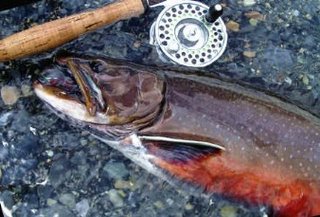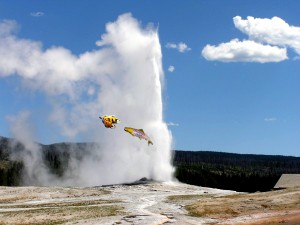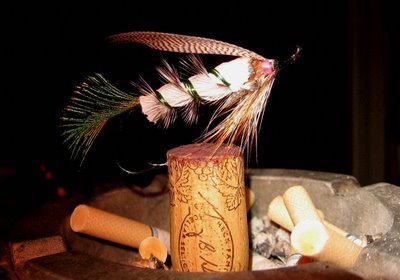.Materials Hard To Find.
.presentation difficult.
.. This has got to be short because it's another Big Sky Day in Yellowstone National Park, and the fishing yesterday was pretty darn good. Our house guests, who left the dismal fishing in Oregon, were introduced to some interesting flies and techniques yesterday in anticipation of the October Caddis Hatch - (which on occasion is sparse.)We, herein, at the risk of being ostracized by the locals, introduce the world to the very secret October Caddis Fly Pattern.
.. Despite the mistaken impressions of geocentric out-of-state-fishers; the Trout in Montana are not on anything so plebeian as crack. The salmonids of the Big Sky State limit their indulgences to USDA Grade #1 Hashish. This enhances their their already keen ability to discern flies from foreign lands, hands, and minds... The sad truth of the matter is that fly fishing in Montana is every bit as good as each of the fisher-folk who fish here. Frequently visitors are disappointed with the fishing in Yellowstone National Park. Well then, no aspersions are cast here, (they twist the leader,) but, there is local knowledge that should not be ignored.
.. This knowledge is hard won and has produced an abundance of locally developed flies that appeal to the heightened perceptions of the local fish. Some of our indiginees have developed a single, superior fly, that is most appealing to the sage trout of Montana's waters: THE FALL REEFER FLY.
.. This fly is delicate and requires mastery of all known fly tying techniques. The presentation is even more difficult, (more later.) Here, for the first time ever, is a picture and the recipe:
All materials are organic and biodegradable - the hook will rust away - should you get cleaned.
- - - - - -
Hook: 5/0 Partridge, (this is for the smallest of the Montana Trout - use larger at your own risk.) Tail: Peacock Sword, Rib: Green Silk Floss, Body Hackle: 15-year-old Whiting Select grizzly hackle,Underbody: Dubbed rope of baby seal fur, spotted owl down, and USDA Grade #1 Hashish, Overbody: pre-smoked refer tube - do not tear, Beard: wolverine eye lashes mixed with young otter guard hairs, Coal: red silk egg-floss, Wing: Wood Duck flank, or Mallard flank, Thread: 6/0 black silk - unwaxed.
_________
.... TYING PROCEDURE: Gather materials. Wrap hook with 3-4 layers of thread, tie in tail. Tie in green silk ribbing and body hackle; form dubbing loop and uniformly distribute dubbing materials. Wrap the dubbing rope forward and backward until it is the same size as the inside diameter of the refer tube, (do not attempt this immediately after procuring the tube.) Whip finish the thread at the front of the hook and cut. Gently slip the refer tube over the underbody, being careful not to disturb any of the burned remnants of the lit end. Wrap the green silk floss forward, whip finish and leave hanging. Follow the floss with the body hackle and tie down with the floss at the front of the fly. Re-attach silk tying thread. Build a red coal similar to an egg pattern. Tie in the beard; tie in the wing; whip finish small head.__________
.... PRESENTATION & FISHING: Use a #12 level line on your strongest 8-weight flats rod. Be sure to have at least 200 yards of monofiliment or braided nylon backing, (20# test should do.) Use about 10" of green Maxima 50# for a shock tippet and no more than 5-feet of Ande Blue 15# for your leader. Attach fly to tippet with hog rings using a Triple-Madison Eye-Loop... As soon as you spot the target fish, LIGHT THE FALL REEFER FLY and present it to the fish. The presentation should resemble a series of false casts. Be as slow, with this casting, as you possibly can - otherwise the fly will burst into flames and destroy the presentation. Keep the fly about 3-feet above the surface of the water and the fish will erupt from it's holding position to take the fly on the way down. Most of us are used to this by now but it excites many visitors to the point of distraction, (often hooking themselves in the lip with a premature evacuation of the hook.) They usually feel no pain as the fly is extracted.
----------
 .. On rare occasions small brook trout will take this fly, but this is an unusual circumstance. Frequently local fishers will stand on the boardwalk at Old Faithful and try for a hook-up with the rare native GEYSER TROUT. This is a new SUPER TROUT that genetic experimentation has developed. This local pastime is far and away more fun than searching for sand trout in Hampton Corners, Oregon.
.. On rare occasions small brook trout will take this fly, but this is an unusual circumstance. Frequently local fishers will stand on the boardwalk at Old Faithful and try for a hook-up with the rare native GEYSER TROUT. This is a new SUPER TROUT that genetic experimentation has developed. This local pastime is far and away more fun than searching for sand trout in Hampton Corners, Oregon.
.. There once were fish of this size in California, too. Sadly they were all caught and the hole they left in the river had to be plugged up with Shasta Dam. We feel sorry for folks in that part of the world. They will never know the joy of REFER MADNESS. - And, without that pleasure they could never be KING OF MISSOULA.






.jpg)






